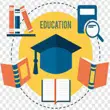The Myanmar School Education Apk is designed for Myanmar teachers and parents of students from KG to 12 so they can learn about education in an easy way. Lessons for KG to 12th standards are included in the app, as well as poetry textbooks and video lessons.
It is a free solution to support children's education during these unprecedented times. Students can study and/or review while parents and teachers can use it to teach. Kindergarteners can watch video lessons from a certified teacher, and students in grades 1-4 can use voice-over lessons from volunteer teachers. Kindergarten students can view and download all content.
As well as lecture modules, Prevent Plastics offered a 'Nyan Keel Lay' section, which included four sessions on environmental awareness, waste management, and SWM best practices.
About Myanmar School Education Apk
It offers many features and tools that simplify and streamline the learning process for students, teachers, and administrators in Myanmar's education system.
It allows students to access their homework and exams, track their progress, and communicate with their teachers. Teachers can also use the app to manage lessons, assign homework, and track student progress. In addition, Myanmar School offers a range of educational resources including video tutorials, e-books, and other learning materials to help students integrate their learning into the classroom wherever they are.
Students, teachers, and administrators are able to easily use and navigate the app, making learning and teaching in Myanmar more efficient, effective, and engaging.
Myanmar School Education Apk Features
Education at the primary level;
After decades of political conflict, Myanmar, formerly Burma, has fallen far behind in terms of quality of education. Although the teachers are good, the old facilities make learning impossible.
Children are required to pass comprehensive exams in the core academic subjects after an optional pre-school period.
Education at the secondary level;
The first phase of secondary education took place in colleges. Students pass grades 6 to 8 before taking their final exams. The education system is generally corrupt, and places in the best schools are often reserved for government officials.
Education to the second level;
Students entering Year 9 can take a combination of Arts and Sciences courses. All students study Myanmar, English, and Mathematics. Humanities students also study geography, history, and economics, while science students tend to study chemistry, physics, and biology. At the end of this period, public school students are permitted to take university entrance exams. Private English schools, however, may not offer this option.
Training in vocational fields;
Young people with little or no work experience are increasingly turning to vocational training, mostly in the private sector, in order to enter the hospitality, tourism, beauty, fashion, nursing, or engineering fields.
Educating the youth;
Students can complete a variety of courses at Burmese universities, but academic freedom remains limited and students cannot freely express themselves, write, or publish.
There are few women's hostels at Yangon University (Rangoon), which has been a hotbed of civil unrest throughout history. Many promising female students from rural areas are excluded from the university because of this.
Highlights
- Traditionally, Burmese and basic mathematics were taught to children in Myanmar's monastic schools. Although public schools have been introduced, many young people continue to attend monastic schools.
- Several Christian mission schools have been established in major cities such as Yangon and Mandalay to accommodate children from high-income families. Myanmar's education system evolved towards a more Western approach under British colonialism. During that time, Myanmar's universities were regarded as the best in the region. However, since the 1962 coup, Myanmar's schools have been nationalized and its educational quality has declined.
- Myanmar has about 47,000 public and private schools. Among them are elementary schools, secondary schools, lower secondary schools, convents, and private schools. Over 40 international schools are located in Yangon, the majority of which are located there.
- The average cost of education in Myanmar- Tuition in public schools in Myanmar is mostly free. The government has waived tuition fees, stationery charges, textbook charges, and union dues for parents and teachers. In Myanmar's flawed public education system, parents still have to pay extra money to send their children to school as it is the only way to adequately cover their children's curriculum.
- The fee structure of each international school in Myanmar is unique, as is the case with most international schools in Asia. The annual fee is an essential part of the school's fee structure. Additional fees include application, registration, and deposit fees. Parents should also be aware of hidden costs, including building construction costs, transportation costs, and uniform and school supply costs.
- Myanmar's education system is managed by the Ministry of Education. Lower and upper secondary schools are under the Ministry of Basic Education. Higher education institutions, on the other hand, are managed by two separate departments: higher education departments 1 and 2.
- Myanmar borders Bangladesh, India, China, Laos, and Thailand in Southeast Asia. Formerly known as Burma, Myanmar is the largest continent in Southeast Asia. In 2019, Myanmar had an estimated 54 million people. Myanmar's two largest cities and economic centers are Yangon and Mandalay.
- Myanmar has a large immigrant population, mostly in Yangon and Mandalay. Many tourists come from Denmark, Australia, and Great Britain.
- Myanmar has gradually improved its quality of life in recent years. However, ethnic minorities and rural communities remain inequalled. In Myanmar, foreigners can find affordable accommodations in big cities. The standard of living in Myanmar is determined by the location, proximity to the city center, and the amenities nearby.
- The main modes of transportation in Myanmar are moto-taxis and rickshaws, while public buses are a great way to explore the main cities like Yangon and Mandalay.
- If you plan to visit Myanmar on business, you must apply for a business visa. This visa permits you to work in Myanmar for 70 days and is required for residency and opening a bank account. To apply for a long-term residency permit in Myanmar, you must have a business visa.
How to Download and Install Myanmar School Education APK:
- Download Myanmar School Education APK from the official website or Google Play Store.
- Your device settings should be set to allow "Unknown sources.".
- The APK file needs to be installed.
- Play the game and have fun.
Conclusion:
The ultimate fighting game for Naruto fans is Myanmar School Education APK. The game offers endless hours of entertainment with its vast selection of characters, customizable controls, and multiple game modes. Anyone who loves Myanmar School Education will enjoy its stunning graphics and special moves and combos. Start battling your way to victory by downloading the Myanmar School Education APK today.









